
|   |

|   |
 e-mail: leelakaverivenkat@gmail.com Brave effort in Delhi by Bangalore based dancers Photos: Vinu Nair July 15, 2017 Steadfastly refusing to be dampened by the sapping heat of summer or the Azad Bhavan auditorium of the ICCR as venue - too far from the art hub of the city to attract a large viewer clientele - not to speak of the scant interest from the scattered city students of dance, Bangalore's Abhivyakti Dance Centre with Manasi Pandya Raghunandan as Director of the festival, mounted what was called the National Dance festival in association with the Indian Council for Cultural Relations, on July 7, 2017. The first half of the event in the form of a seminar featured senior dancer Geetanjali Lal, Ranjana Gauhar, Bharati Shivaji and Prathibha Prahlad, along with Guru B.K. Shyam Prakash, Founder Director of Sanskruthi Bhavan Keshava College of Music and Dance, Bangalore, Dr. Uma Rele, Principal Nalanda Nritya Kala Mahavidyalaya, Mumbai, and this writer. Cautioning against the craving in dance aspirants for catapulting to stage performances even before gaining proficiency in the art form was Geetanjali Lal's narration of the lambasting she received from her Guru Roshan Kumari for having succumbed as a child student to performing in a event. That learning a dance form entailed much larger effort involving study of other disciplines beyond only body movement and that the process of the learner's inner growth could not be hurried was a point stressed by this writer also in the opening talk. Bharati Shivaji provided glimpses of her journey to Kerala meeting Kavalam Narayana Panikkar, which threw open to her a whole world of Mohiniattam and its challenges and Ranjana Gauhar dwelt on what the Guru/Shishya relationship entailed. While Guru B.K. Shyam Prakash referred to the twin theory/practice knowledge that large institutions could and did provide, he also derided the half baked dancers parading as 'Gurus.' Dr. Uma Rele provided some insight into how an institution like Nalanda Nritya Kala Mahavidyalaya functioned and the kind of grooming it offered to dance disciples. The last speaker, joining in late, Prathibha Prahlad while roundly denouncing the devaluation of terms like 'Guru' which ordinary 'teachers' now assumed, also maintained that the Guru Shishya Parampara we love to talk about had ceased to exist, with dancers of her time perhaps having had training experience under the last of the traditional gurus. In round terms, the speaker decried the total absence of critics and critical writing (largely true of much of the gushing review scene) today. She failed to mention however that dancers as a class need to develop a more healthy attitude towards criticism - not always wanting hosannas and being very prickly about adverse comments - with critics being valued and cherished often by how much adulation they heap on the dancer. She also said that not all those who are learning how to dance can become 'artists', though they may all dance. 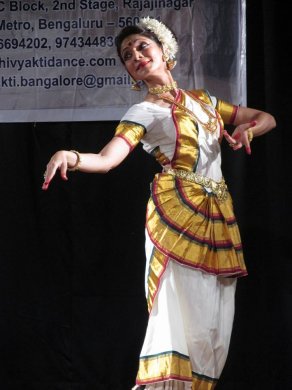 Vani Pahwa In the performance part, the first lot of dancers did their teachers proud. Opening with the Mohiniattam suite, Vani Pahwa disciple of Bharati Shivaji, in her rendition of the Chollukettu done to music in Arabhi (both dance composition and music sung by Radhakrishnan, are by Bharati Shivaji) had all the lilting grace that Bharati's Mohiniattam is known for. The composition was woven with mnemonics of the edakka and the maddalam, both percussion instruments used in Mohiniattam. The nritta projection concluded on a fleeting interpretation of a two line sahitya about Vishnu manifesting as the powerful / beauteous Mohini enrapturing Shiva - and from this union being born Ayyappa. The dancer stopped with just one item while others presented two items each. 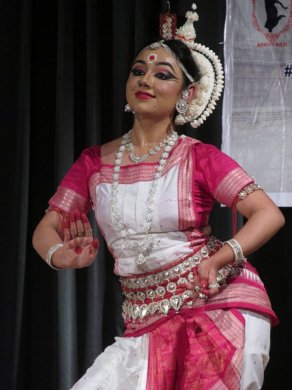 Vrinda Chadha Odissi by Ranjana Gauhar's student Vrinda Chadha draped in a tasteful costume, showed a complete dancer combining involved abhinaya with grace and precision of nritta. The Ardhanariswar Shloka, based mainly on Shankaracharya's literary composition showing Shiva and Parvati enshrined in one identity comprising polarities in a complementary contrast, along with a couplet, "Vaak artha iva sampruktau..." from Kalidasa's Raghuvamsham woven in, describing the couple as inseparably united, like the word and its meaning. The composition was set to music by Bankim Sethi in a ragamalika / talamalika creation with dance composition by Ranjana Gauhar. Apart from bringing out the polarities of the two divine figures powerfully, Vrinda's dance was suffused with the joy of movement, very strongly communicated. Based on pure technique but as enchanting was the lilting Shankarabharanam Pallavi (the music from Pankaj Charan Das' repertoire, with dance movements by Ranjana's Guru Mayadhar Raut) . 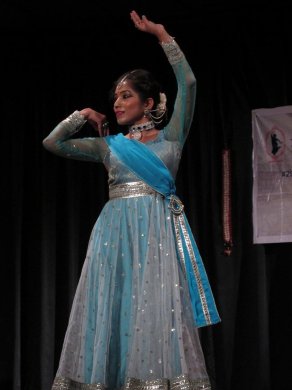 Garima Arya The Kathak dancer Garima Arya who began her career as a Jaipur gharana learner before switching on to training under the Lucknow gharana doyen Pandit Birju Maharaj and his students Saswati Sen and Pandit Deepak Maharaj, demonstrated all the poise and finish of an evolved dancer. After a short invocation to Ardhanariswar in teental in three layas, vilambit, madhyam and drut, the dancer's pure dance brought into play all the Kathak intra-forms in style - the slickness of sudden freezes, and movements of neck and wrist joints impeccable in tala and subtlety - with the Paremelu followed by the smoothly executed Chakradhar Paran, ending in a short jugalbandi - the total effect compounded by the excellent tabla support of Pramshu Chaturlal, and nagma refrain provided by Warez Khan on the sarangi, with vocal support by Rajnandini. One would have liked to see more abhinaya representation to balance the presentation. 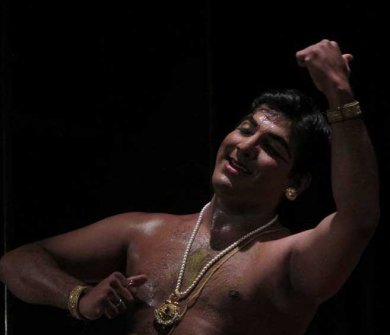 S. Raghunandan Bharatanatyam projection was by one of the founder/ teachers of Abhivyakti, S. Raghunandan, grandson of late H.R. Keshavamurthy. The choice of Maharaja Swati Tirunal's Bhavayami Raghuramam in its ragamalika version, composed by late Semmangudi Sreenivasa Iyer, gave scope to both the mimetic and the rhythmic in the story of the Ramayana in a narrative form where the story telling allows little room for elaboration. The Dandakaranya sequence in Mohanam, with the fleeting appearance of Shoorpanakha and Jatayu was convincing. For this critic, given the malleable facial expressions of the dancer, the character of Hanuman with the inverted mukula hasta, symbolising the monkey could have emerged with stronger articulation. Given a more experienced compere as master of ceremonies, the formalities of honouring invitees and artists could have been smoother taking up less time. By the time the younger dancers got the stage, it was too late in the evening and most of the audience, including this critic could not stay. But a hearty vote of appreciation for the Abhivyakti effort in staging an event in Delhi while based in Bangalore. Divya enthralls small but discerning audience One wonders why classical dancers run after large audiences. Populist responses as for cinema cannot be experienced in art forms which require discerning viewers with a degree of initiation into the art form. Late musician Pandit Malikarjun Mansoor, who in a matter of fact manner mentioned that he had often performed for near empty halls, because his commitment to the singing was never affected by the number of people in the audience, provided an object example of how classical artists can find satisfaction in small audiences having more sensitivity towards the aesthetics of their art form. 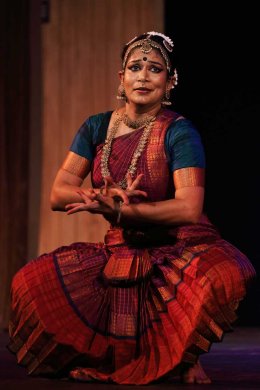 Divya Devaguptapu Photo: Inni Singh At Habitat's Stein auditorium, a slender but attentive audience conveyed in no uncertain manner its appreciation for Divya Devaguptapu's Bharatanatyam recital. This senior disciple of the Dhananjayans and visiting faculty of dance at the University of California, San Diego, has strangely, not been seen by Delhi audiences earlier. Right from the opening item Sannadhi tracing stillness through movement, the dancer's quality spoke. The dance composition based on rhythmic syllables of the Alaripu in Bharatanatyam, comprised movement drawing lines in space forming architectonic geometry of a temple, with straight lines, diagonals, triangles and circles - suggesting through the tam dhit tam thai tat thai syllables the sculpted images in the temple niches and walls. From the ringing bells to the lamp lighting, here was a symbolic journey traced from the outside to the inner sanctum, the ragamalika music setting the devotional tone. Though rendered to taped music, the evocative singing by Sreedev Rajagopal gave the music a feel of immediacy as in live music. The Maharaja Swati Tirunal varnam in Todi, Dani Samajendra gamini...tapam iha Kamini with a tuneful ragam prelude by violinist Ishwar Ramakrishnan, and later flute interventions by Shruti Sagar, registered a true climax in nritta and abhinaya. Having lost her heart to Padmanabhaswamy with the majestic walk like the elephant's, the nayika pleading with her friend to play love messenger, describes the ideal setting in nature dressed in the garbs of madhu masa, with swarming bees, cooing birds and the cow with her calf - all in pairs while she alone without her loved one who is the Creator himself, pines in solitary loneliness. The wonder of every door in the temple opening out to the glory of the Lord inside was well brought out in the interpretative part. The teermanams composed by mridangist Ramesh Babu, bristled with rhythmic zest, though I could not help feeling that the percussion support he provided needed to be leaner in places without the uniformly heavy accompaniment which tended to overwhelm very often, drowning out singer and Venkatakrishnan's nattuvangam. Divya's compositional skills while never crossing the conventional vocabulary saw the dancer getting away from too much frontal dancing by angling movements to both sides of the centre, enabling closer communication with the scattered audience in the hall. Divya's involvement in the abhinaya won high marks. The best of the performance came in the rare Kshetrayya padam in Kalyani, Na manasu vantide nee manasaite na nonu phalameede rura, dedicated not to his customary Muvvagopala but to Varada of Kanchi. This lyric is an intense declaration of love felt by the divya nayika here penning a letter to her loved one. She says that if his mental condition is like hers during their absence from each other, with her seeing him and feeling his presence everywhere, then her penance is fulfilled. After this when the sugarcane grows in abundance, their union, when they meet will have greater joy. The singing accompanied by the internalised strength in the abhinaya made for a compelling love statement. To bring down the curtains on this recital was the tillana in Kamas, a composition of late Lalgudi Jayaraman following which the Annamacharya verse Maya Mohamu with the endorsement that in a world full of the temptations of all types, the only refuge was Lord Venkateshwara, provided the right spiritual tone to end the performance with.  Writing on the dance scene for the last forty years, Leela Venkataraman's incisive comments on performances of all dance forms, participation in dance discussions both in India and abroad, and as a regular contributor to Hindu Friday Review, journals like Sruti and Nartanam, makes her voice respected for its balanced critiquing. She is the author of several books like Indian Classical dance: Tradition in Transition, Classical Dance in India and Indian Classical dance: The Renaissance and Beyond. Post your comments Please provide your name and email id when you use the Anonymous profile in the blog to post a comment. All appropriate comments posted with name & email id in the blog will also be featured in the site. |